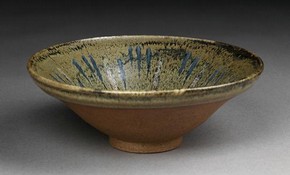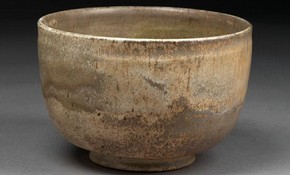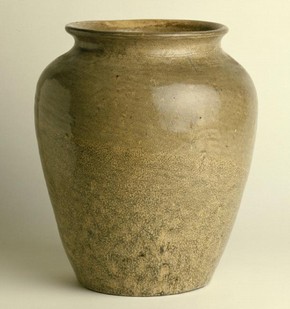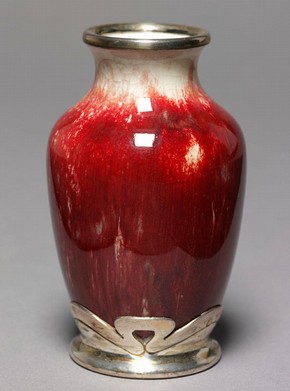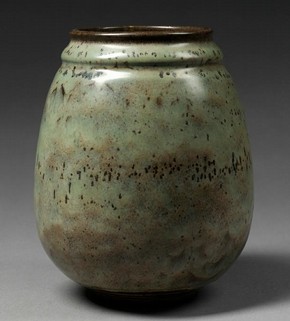V&A Online Journal
Issue No. 4 Summer 2012
ISSN 2043-667X
William Bower Dalton: Potter and teacher
Lily Crowther
Research Assistant, British Design 1948-2012Victoria & Albert Museum
Abstract
William Bower Dalton (1868-1965) was a pioneer of studio ceramics in Britain. His work was particularly noted for its sophisticated and subtle glaze effects. He was also an influential educator, head of Camberwell School of Arts and Crafts from 1899 until 1920, and simultaneously curator of the South London Art Gallery. This article examines his life in detail for the first time.
Introduction
Amongst the glamorous and charismatic pots in the V&A’s gallery of twentieth-century studio ceramics nestle two small bowls, so quiet and restrained that they might easily be overlooked (fig.1 and 2).One is glazed in a warm dusty brown, with a hugely varied texture, like a landscape in miniature. The other has an irregular pattern of dark and light splashes on a green ground covered in black flecks, the result of layering glazes over one another. In both, the modest simplicity of the form is complemented by the surprising complexity of the surface. These bowls are by William Bower Dalton, a pioneer in British studio ceramics and an important figure in the history of craft education. Dalton was among the first generation of ceramic makers to take inspiration from early Chinese ceramics, before the widespread popularity of Japonisme in Britain. Along with his contemporaries in France and America, he experimented with the possibilities of stoneware bodies and high-fired glazes in an attempt to rediscover forgotten techniques.
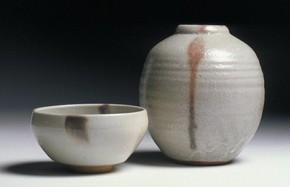
Figure 3 - Bowl and vase, William Staite Murray, 1924 and 1927. Museum nos. C.1455-1924 and CIRC.677-1927
Dalton served as Principal of Camberwell School of Arts and Crafts from 1899 to 1920, during which time notable students of ceramics at the School included William Staite Murray (fig.3), Charles Vyse, Roger Fry and Reginald Wells (fig.4). Dalton exhibited with Bernard Leach, Michael Cardew and other leading figures in the studio pottery movement in the 1920s and 1930s. He was curator of the South London Art Gallery for more than twenty years, and a member of several influential societies and committees in the fields of industrial art and education. Yet despite his central position in the establishment of his day, he is now largely forgotten. This is a shame, because to look at his life and work is to gain an insight into the educational and aesthetic ideals of his age.
This article sketches his biography for the first time, and attempts to set his life in the context of late 19th and early 20th century craft education and production.
Dalton’s early life
William Bower Dalton was born in Wilmslow, Cheshire, on the 29th of February 1868. (1) He was the second child of Thomas Dalton, a lithographic artist, and his wife Sarah. It was not until the 1880s that lithography became affordable for use in magazines, so at the time of William’s birth Thomas would have been working on upmarket illustrated books or prints. One can imagine that this was a household in which youthful artistic talent was encouraged. By the time William reached the age of 13, his parents must have been finding it increasingly difficult to make ends meet. They were now supporting seven children at home,in addition to William’s older sister Mary Bower, who was at boarding school. (2) The family no longer kept a servant, as they had done ten years earlier. (3) (4) But the Daltons made no compromises in the education of their eldest son. William began his studies at Stockport Grammar School, and then in 1888 moved on to Manchester School of Art.
Manchester School of Art had begun life in 1838 as a Government School of Design, becoming the School of Art in 1853 and moving to its present home in Cavendish Street in 1880. The school enjoyed close links to the artistic establishment and in particular the Arts and Crafts movement. Its direction was influenced by Charles Rowley, picture frame maker, patron of the Pre-Raphaelite artists and a leading figure in Manchester art circles; Rowley offered the post of Director of Design at Manchester to the illustrator and designer Walter Crane in 1892, and Crane took up the post the following year. (5) The school’s Gothic building, completed in 1880 by G.T.Redmayne, pupil and brother-in-law of the prominent Gothic architect Alfred Waterhouse, also contributed to the atmosphere. Dalton’s time there may have shaped his attitude to arts education and the value of craft skills:he took his first lessons in throwing on the potter’s wheel at Manchester, and throughout his career, he was a passionate advocate for the importance of the applied arts. (6)
While many of his younger siblings worked for a living, William was to continue his studies until he was almost 30 years old. (7) Around 1892 he quit Cheshire for London and the National Art Training School (soon to become the Royal College of Art). At that time, the School was part of the Victoria & Albert Museum, so studying there gave Dalton access to unparalleled collections of Asian and European ceramics; it was perhaps here that his mature interest in pottery was first sparked, although his early work focused on painting. He was clearly a promising student – in 1894, he was granted a travelling scholarship to Italy. His four years at the National Art Training School would have left Dalton with an invaluable network of friends and contacts, providing the foundations of his future life in the London artistic community.
Shortly after his graduation in 1896 Dalton was appointed as a lecturer at Huddersfield School of Art, where he remained for two years. Then, in 1899, an opportunity arose in London: Cecil Burns, the Headmaster of the newly founded Camberwell School of Arts and Crafts, left his post after only a year to take charge of the Sir J.J. School of Art and the Victoria & Albert Museum in Bombay. (8) Dalton took his place, and went on to lead Camberwell for 20 years.
Dalton at Camberwell
When he arrived at Camberwell School of Arts and Crafts in 1899, Dalton was still just 31 years old. He had done well to get the job in a competitive field – there were 71 applicants, and the final shortlist included John Williams, head of the Artistic Crafts department at the Northampton Institute in Clerkenwell (now City University), and Archibald H. Christie, an architect who had taught at the Central School of Arts and Crafts. (9) As well as Headmaster of the school, Dalton also became curator of the South London Gallery next door. (10) This was a separate appointment, but the two posts had been held by the same person since the establishment of the twin institutions, and it was felt to be in the best interests of the school that this should continue to be the case.
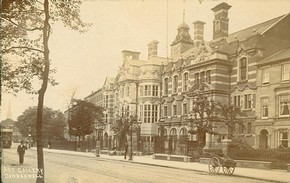
Figure 5 - Camberwell School of Arts & Crafts, about 1910. From the Southwark Local History Library & Archive
The South London Gallery had opened in 1887 with a small collection of pictures on loan from various artists; its President was the Aesthetic movement painter Lord Leighton. In 1892 the Gallery’s fortunes were transformed by the philanthropist John Passmore Edwards. Passmore Edwards had made his fortune as a newspaper proprietor, and devoted his profits to charitable causes, taking a special interest in projects relating to workers’ education and self-improvement. He gave £3000 to build a library and lecture-hall alongside the Gallery. By 1896, the scale of the enterprise had become too great for the Gallery’s founders to manage, and control was transferred to the local authority, Camberwell Vestry. Camberwell thus became the first local authority in London to run an art gallery under the Public Libraries and Museums Act. Passmore Edwards went on to fund a new building to house the Gallery and a new school of arts and crafts, which opened in January 1898 (fig.5). (11)
As the dignitaries at the opening of the Camberwell School of Arts and Crafts remarked, ‘Camberwell was now placed at the forefront of the municipal life in London, because it was the first parish in which there was an art gallery and technical institute under the control of the vestry’, and although, ‘they could hardly boast that in Camberwell today they were the possessors of any great quantity of beauty … they were deeply grateful for the generosity which made accessible things of beauty to crowds of hard-working people.’ (12) (13) This last comment reaches the heart of the philanthropic impulse behind the founding of the Gallery and School. Both were intended primarily for the benefit of the local working-class population. Unlike many public collections, the Gallery was open in the evenings and on Sundays to allow working people to visit. The School, meanwhile, taught young people during the day, and in the evenings ran courses enabling older students, already working in relevant industries, to improve their skills. The painter and designer Sir Edward Poynter, then Director of the National Gallery, President of the Royal Academy and former head of the National Art Training School, suggested at the opening ceremony that:
Schools of art might be of greater value if their proper purposes were kept in mind, and if it was remembered that a dilettante admiration for old art and enthusiastic talk about beauty of form and feeling for colour went for nothing … They had in this country designers enough and to spare … What they wanted were fine and thorough handicraftsmen who would put their best work into all they did for the love of art. (14)
The School was thus run with the aim of improving the standard of workmanship in London’s industries, as well as the level of personal satisfaction which the workers derived from their occupations. The evening classes in particular allowed production-line workers to ‘master all the details of the handicraft which is their life’s work, instead of only the one isolated and specialized feature to which they are generally confined by the rigour of the modern industrial system’. (15) This ideal owes much to William Morris, although with a less ambitiously utopian aim – Camberwell graduates were not supposed to retreat to a peaceful workshop in the countryside, but to deliver better, more beautiful industrial products for mass consumption. The course fees varied ‘according to occupation and income’, and classes were free for ‘persons under 21 years of age qualified for admission to the school and bona fide engaged in the trade.’ (16) Despite this incentive for young learners, the student body was dominated by older men and women attending evening classes – by 1912, they outnumbered the day-students by 500 to 200. (17)
If Dalton’s new role carried considerable responsibility, it also brought commensurate rewards. He earned £400 per annum as Headmaster, and a further 50 guineas as Curator, making a total of £452 10s. (18) After his years as a student, Dalton was finally in a position to support a household of his own. Early in the summer of 1900, he married Mabel Plummer. (19) Mabel was 24 years old, the daughter of Henry Plummer, a Manchester insurance manager, and his wife Lucy. She was well educated – while her older sister Ethel and their three brothers had remained at home, Mabel had been sent to boarding school. (20) The Plummers occupied a somewhat higher social stratum than Dalton’s parents: they kept a nursery-maid as well as a general servant. (21)
By 1901, William and Mabel Dalton had set up home at 20 Solway Road, East Dulwich,about 25 minutes walk south of the art school.A general impression of the area is provided by Charles Booth’s ‘Inquiry into the Life and Labour of the People in London’, a survey of working class life conducted between 1886 and 1903. (22) In his ‘Descriptive Map of London Poverty’ of 1898-9, in which all streets in the capital were assigned a colour ranging from yellow for ‘wealthy’ to black for ‘vicious, semi-criminal’, Booth classified Solway Road as ‘fairly comfortable’. His notes describe it as being newly built on the gardens of East Dulwich Road, a method of infill typical of London’s increasingly dense suburbs; the houses each had eight rooms, and were let at £40 a year. (23) According to local historian H. J. Dyos, the district of East Dulwich included, ‘a number of well-to-do streets occupied mostly by professional people’, but was largely working class at the turn of the century.25 Generally speaking, ‘the longer and straighter and flatter the street, the fewer pretensions it normally had’; by this measure, Solway Road, being extremely short and curving round a sharp corner, must have been near the top of the social scale. (24) The street’s residents included a journalist, an upholsterer’s salesman, a draper, a caterer, a tailor and a builder, showing the mixed nature of the area. (25) Unlike most of their neighbours, the Daltons were able to keep a servant. (26) Both of their daughters were born in Dulwich: Helen Mabel in 1905, and Rotha Holroyd in 1908. (27)
As the working class population of the district of Camberwell grew, the School of Arts and Crafts was gradually expanding to serve this new community. New courses were introduced each year, following demand or the perceived needs of local employers. The decision to set up a ceramics course was taken in July 1907; a natural local constituency of students would have been provided by the nearby Doulton factory in Lambeth. Richard Lunn, head of ceramics at the Royal College of Art, was brought in to head the new course, which took in its first students in September of the same year. The course was on a modest scale at first – Lunn taught one evening per week, with the assistance of a professional thrower who made vessels for the students to decorate; it was only later that the students themselves learned throwing.
In its early years the ceramics course attracted a number of students who went on to make important contributions to studio pottery. One of the first was Reginald Wells, who trained as a sculptor at the Royal College of Art but began making pottery around 1900. Wells’ early work drew inspiration from traditional English wares, but after the First World War he was particularly influenced by Chinese ceramics, experimenting with high temperature firing and textured glazes. Wells was followed by William Staite Murray, who was at Camberwell from about 1909 to 1912. Inspired by Japanese ceramics and Zen Buddhism, Staite Murray became the leading advocate of pottery as a form of fine art. He gave his large pots expressive titles, showed them in Bond Street galleries, and priced them accordingly. Following Staite Murray,Charles Vyse studied at Camberwell in 1912, and Roger Fry in about 1912-13. Vysehad been an apprentice at Doulton before studying sculpture at the Royal College of Art from 1905 to 1910. Together with his wife Nell, he made popular slip-cast figurines, but also developed an interest in Chinese Sung pottery and experimented with glaze chemistry. Fry, a member of the Bloomsbury Group, founded the Omega Workshops in 1913, where he and others made boldly coloured ceramics in strong shapes, alongside other household goods and furnishings. Clearly the course attracted students of a high calibre, and fostered an appreciation for the elegant simplicity and striking glaze effects of East Asian pots.
By 1917, Camberwell School offered day, afternoon and evening classes in subjects ranging from building construction and cabinet making to bookbinding and dress design. Students’ work was regularly exhibited at the South London Gallery, and seems to have been well received by audiences. In 1911, a reviewer described the annual exhibition as, ‘an arresting proof of the value of the work which is being done under the London County Council and Mr W. B. Dalton in providing instruction in those branches of design and manipulation which directly bear on the more artistic trades’. (28) Two years later, the quality of the work on display was praised as a testament to ‘the intelligence of the students and the activity and wisdom of the principal, Mr W. B. Dalton, and his assistants’. (29)
As well as showcasing students’ work, the Gallery had an active programme of temporary exhibitions designed to appeal to the student body and to local audiences more generally. The displays focused on craft skills and techniques as well as finished artworks; for example, to accompany an exhibition of Japanese prints in 1898, there was, ‘a demonstration by Mr [Frank] Morley Fletcher on the methods of printing in colour from wood blocks’. (30) An exhibition of British watercolours in 1904 included sketches and studies to demonstrate the artists’ methods. Alderman C. T. Harris, speaking at the opening of the exhibition, noted that, ‘The exhibits included works by Cox and Turner, both men of poor parentage. It might happen that men might be attracted to that gallery who were equally gifted and who needed only the opportunity to develop into great artists.’ (31)
Despite the interrelationship of the two institutions, it was not always easy for Dalton to head the School and Gallery simultaneously. It appears that not all of the local councillors appreciated the demands on his time and expertise exerted by his curatorial work. In 1906, the council held a very public dispute about his pay, eagerly reported in the local newspaper. (32) It was proposed that his salary as Curator should be increased from 50 guineas (the level at which it had been set since he took up the post) to £75 per annum. The justification for this substantial increase was that the local council was in a better financial position since London County Council had taken over the Art School; on the other hand, Dalton’s salary as Principal of the Art School was generous enough for some councillors to dispute whether any increase in his second income was justified. When the council declined to approve the raise, Dalton submitted his resignation, generating a further flurry of disagreement among the councillors, who eventually resolved to offer him £60. Dalton declined this offer, but evidently some compromise was reached, because he was to remain at the Gallery long after his retirement from the Art School.
Dalton the studio potter
It is difficult to be sure exactly when Dalton began to make pots, or how quickly they became the dominant element of his work. In his early years at Camberwell he worked in a variety of media, following the pattern set by the luminaries of the Arts and Crafts movement. His contribution to the Arts and Crafts Exhibition Society show in 1906 was a pair of chairs (both ‘executed’ by H. Martin), and when he joined the Art Workers’ Guild in 1908 it was as a ‘designer’. (33) He continued to exhibit paintings until at least the 1950s, and also had a lifelong interest in lettering design. (34)
In 1920, Dalton left Camberwell School to spend more time at Garrow, the house and studio in Longfield, Kent, which he had designed for himself ten years earlier. (35) Although he continued as curator of the South London Gallery for another decade, he was increasingly dedicated to studio pottery. By the early 1920s, he was exhibiting his ceramics in high-profile forums – in 1923, a bowl and a figurine entitled ‘The First Dip’ were shown at the Stedelijk Museum, Amsterdam, in an exhibition organised by the British Institute of Industrial Art (BIIA); the BIIA had been set up in 1920 by the then director of the V&A, Cecil Harcourt-Smith, to collect and show the best modern design.
In 1924, Dalton became President of the Potters’ Guild. He was also active in promoting good design in industrial ceramics. He served on the juries of several exhibitions, such as those held by the Ceramic Society at Stoke in 1919 and at Hanley in 1920 which were praised for promoting, ‘a remarkably high standard of refinement and good taste’ through criticism as well as praise: ‘For educational reasons pottery which is below the accepted standard is included, the adjudicators clearly stating the nature of the defects’. (36)
Dalton was interested in a wide variety of historical ceramics, particularly Hispano-Moresque and Turkish pieces, of which he had a personal collection. But he admired early Chinese ceramics above all others, and devoted his energies to emulating their precise, sober forms and sophisticated glazes. Knowledge of early Chinese pottery only became widespread in the West in the early 20th century, following the first European scholarly publications on the subject in the 1880s. With no way to establish exactly how potters in China had achieved their glaze effects, Dalton and his international contemporaries embarked on extensive experimentation. Dalton relished the unpredictability of his medium, and kept diligent records of the effects of every variation in glaze recipes and firing. He would later say, ‘One must record mistakes, whether reasonable, experimental or stupid’. (37) He was particularly interested in combining different glazes and observing their interactions, and some of his most attractive surface effects were achieved by dipping a completed piece into one glaze and then another, creating a pattern of contrasting streaks reminiscent of a traditional East Asian ‘hare’s fur’ glaze. As one would expect from a maker engaged in an extensive programme of trial and error, some of Dalton’s pots appear to be failed experiments. For example, one piece in the Cuming Museum collection (formerly housed at the South London Gallery) has a thick white glaze, which crawled drastically during firing, leaving wide channels of bare clay. It is a testament to Dalton’s enquiring mind that this pot survives as evidence of the results of a particular combination of glaze and heat; perhaps he intended it as a teaching aid for young potters.
Much important experimentation in glaze techniques was done in France. The pioneer of the field was Ernest Chaplet, famous for his mastery of spectacular flambé glazes (fig.6). Chaplet was also important in establishing stoneware as a suitable alternative to porcelain for art pottery, having seen examples of Japanese stoneware at the Paris Exhibition of 1878 (fig.7). The British-born ceramicist Taxile Doat, based in Paris, was also highly influential in popularising East Asian styles; he worked at Sèvres from 1877 to 1905, as well as running his own private workshop, and was known for his inventiveness in developing high-fired glazes for porcelain. Dalton took a particular interest in the work of another French potter, Émile Decoeur (fig.8). He visited Decoeur’s widow in 1954 hoping to purchase his notebooks, but, in accordance with Decoeur’s will, they had been destroyed after his death. (38) Dalton then set about trying experimentally to replicate his glazes and methods. He had a number of Decoeur pots in his own collection: in 1957, he gave a Decoeur bowl to the Royal Ontario Museum, Toronto, and expressed the desire to give another example of a different type at a later date. (39)
Dalton’s interest in early Chinese wares and glazing techniques was also shared by contemporaries in North America. These included Hugh Robertson of the Chelsea Ceramic Art Works, who discovered a recipe for deep red sang-de-boeuf glaze in 1888, and the educator Charles F. Binns, the first director of the School of Clay-Working and Ceramics at Alfred, New York. Binns, like Dalton, combined his work as a potter with enthusiasm as a teacher, and shared the recipes for his rich monochrome stoneware glazes with his students and in a series of published works. This interest in Chinese glazes was, however, unusual among British potters of the time, who, like Bernard Leach, looked mainly to Japanese models, or to traditional English slipware and lead-glazed ware. Compared to work by his British contemporaries, Dalton’s pottery is notably subtle in decoration, with a consistent focus on the colour and texture effects of minor variations in glazing.
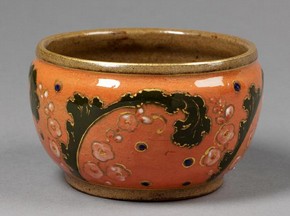
Figure 7 - Bowl, Ernest Chaplet, probably decorated by A. L. and E.-A. Dammouse, about 1885. Museum no. C.308-1983
Critics praised Dalton’s work for its qualities of restraint and simplicity, and especially for its glazes. For example, a reviewer attending the South London Group’s annual exhibition in 1926 described his stoneware as, ‘soberly beautiful’. (40) In 1928, Dalton’s work was included in the English section of the International Exhibition of Contemporary Ceramic Art organised by the American Federation of Arts. Reviewing the show, C. Louise Avery noted that the English contributions were, ‘simply modelled, subdued in tone, and conservative’, but went on to praise Dalton for the, ‘great depth and brilliance’ of his glazes. (41) One reviewer of a group show of ceramics at Colnaghi in 1932, while singling out Michael Cardew for particular praise, noted of Dalton’s pots that ‘the quality of their glazes is remarkably high’. (42) A fascinating review of the regular Arts and Crafts Exhibition Society Show in 1935 discussed the continuing relevance of the Society as, ‘a complement, or a corrective’ rather than, as it had initially been intended, a, ‘reaction against the mechanization of life’. (43) To demonstrate the importance of the exhibition, the reviewer picked out a number of works, ‘which are not only good in themselves but good in a way which is only possible in handicraft conditions’, choosing from the pottery section pieces by Cardew, Leach and Dalton. His being mentioned in this company indicates the high regard in which his work was held at the time.
Dalton’s work is found in a number of important UK museums and galleries. Naturally, by far the largest collection was built up by the South London Gallery: 36 pieces (now in the care of the Cuming Museum), including figurines and tiles as well as vessels, covering the whole extent of Dalton’s working life in Britain.Most other examples of Dalton’s ceramics in British public collections date from the 1930s, by which time he was well established in commercial galleries and group exhibitions. Manchester Art Gallery holds the largest collection of his work outside London, with six pots purchased between 1931 and 1937, and a further five 1930s pieces bequeathed to the collection in 1948. (44) Dalton actively encouraged Manchester’s curators to consider his work, perhaps hoping for a good representation in his home city – he wrote to the chairman of the gallery committee in 1931 to ‘remind’ him of the upcoming Arts and Crafts Exhibition Society show at the Royal Academy, offering to meet him there and, ‘explain my pottery to you’. (45) The V&A’s two Daltons were made in 1933, and acquired by the museum in 1934 as part of a collection formed by the British Institute of Industrial Art, which had clearly continued to encourage Dalton since first showing his work ten years earlier. (46) Gallery Oldham also has a Dalton bowl probably dating from the 1930s, which was given to the Gallery by the Contemporary Art Society (CAS) in 1943. Founded in 1910, the CAS focused on fine art; the fact that Dalton’s work was being purchased simultaneously by the BIIA and the CAS indicates the liminal position of studio pottery at the time, as an area of overlap between art and design. The Crafts Study Centre holds a piece exhibited by Dalton in 1934 at the Red Rose Guild’s exhibition in Manchester, and given to the Centre in 1977,and Salford Museum & Art Gallery has three pieces dating from 1932 to 1935.
The most important private collector to hold an example of Dalton’s work was the Very Reverend Eric Milner-White, then at King’s College Cambridge and later Dean of York. A member of the Advisory Council of the V&A, Milner-White built up an extraordinary collection of work by the most influential early studio potters. (47) He purchased a bowl exhibited by Dalton in 1928, later donating it to York Art Gallery.In the late 1950s, two examples of Dalton’s work were acquired by Wakefield librarian Bill Ismay. (48) Ismay also gave his collection to York Art Gallery, who therefore have a total of three Dalton pieces.
‘Garrow’, Dalton’s home and studio, was destroyed by bombing in 1941, and he emigrated to the United States, settling in Stamford, Connecticut. He continued to participate in the artistic life of London, exhibiting with the South London Group in the 1950s, and publishing three books on the history and practice of ceramics in 1957, 1960 and 1962. (49) (50) These describe his methods and inspirations, and are aimed primarily at the practical-minded student. The first book gives a brief history of world ceramics, focusing particularly on China and on the methods and materials used by potters throughout history, and goes on to describe modern workshop equipment and techniques. Dalton explains that, ‘the book especially stresses the importance of experiment with glazes, seeking for rare qualities of texture and colour, for only in this way can further advancement be made’. (51) In his second book, Dalton’s focus is almost entirely technical, laying out notes on subjects such as the new metal oxides made available by the latest science, how to prepare clay bodies and glazes, and how to pack pottery for dispatch by post. The final book repeats the structure of the first, beginning with an overview of ceramic history, focused this time on medieval and early modern European pottery, and following this with an outline of workshop methods. Taken together, the books underline Dalton’s preoccupation with glaze techniques, historic and modern, as well as his commitment to passing on his accumulated knowledge to younger generations.
Examples of Dalton’s later work can be seen in museum collections in North America. The Cooper-Hewitt National Design Museum in New York acquired two pieces in 1957, both bulbous stoneware vessels, one with a brown mottled glaze and the other glazed in brown and grey. There are a further six pieces in the Royal Ontario Museum, Toronto, of which five are porcelain and one stoneware, all with celadon glazes and all of a very small size. Five of these were acquired directly from Dalton between 1952 and 1954, and one was purchased from the New York dealer Warren Cox in 1950. Although Dalton was clearly active in the studio into his 80s, these late works are much less ambitious in terms of scale and surface effects than his earlier pieces.
In 1965, aged 97, Dalton returned to England. He died in the same year, and his pioneering contribution to British studio ceramics and craft education has since been largely forgotten. Looking back now at his work, and particularly at the enduring importance of Camberwell School of Arts and Crafts (now Camberwell College of Arts) as a centre for innovation in studio ceramics, it seems appropriate that his memory should be revived.
Endnotes
(1) 1871 census. The National Archives (TNA): Public Record Office (PRO) RG 10/3680/24.
(2) 1881 census, TNA: PRO RG 11/3501/54.
(3) 1881 census, TNA: PRO RG 11/3510/16.
(4) Dolman, Bernard. ed. Who’s Who in Art. London: The Art Trade Press, Ltd., 1927:59.
(5) 1891 census, TNA: PRO RG 12/2820/33.
(6) Dalton,W. B. Just Clay. Bristol: published by the author, 1962:ix.
(7) Macdonald, Stuart. The History and Philosophy of Art Education. London: University of London Press, 1970: 294-5.
(8) Now the BhauDaji Lad Museum.
(9) Camberwell School of Arts and Crafts Joint Advisory Sub-Committee minutes for 3 July 1899, point 2, Camberwell College of Arts Library.
(10) From 1904, the job was retitled ‘Principal’.
(11) For a more detailed discussion of the development of arts provision in Camberwell and other London suburbs see: Crowther, Lily. ‘Et in Suburbia Ego: a cultural geography of craft in the London suburbs’. Journal of Modern Craft 3/2 (July 2010): 143-160.
(12) Scott-Scott, W. Chairman of the Libraries and Museums Committee of Camberwell Vestry. Quoted in ‘South London Art Gallery’. The Times, January 7, 1898.
(13) The Bishop of Rochester, quoted in ‘South London Art Gallery’. The Times, January 7, 1898.
(14) Quoted in ‘South London Art Gallery’. The Times, January 7, 1898.
(15) ‘South London Art Gallery’. The Times, January 25, 1911.
(16) Advertisement in The Times, September 19, 1917.
(17) ‘Camberwell School of Art’. The Times, January 24, 1912.
(18) Average earnings in 1902 were just £72 16s per annum. See Lindsay, Craig. ‘A century of labour market change: 1900 to 2000’. Labour Market Trends 111/3 (March 2003): 141.
(19) England and Wales marriage index, April-May-June 1900, vol. 10b: 1337. The marriage was registered in Kendal.
(20) 1891 census, TNA: PRO RG 12/3171/21 and RG 12/3033/29.
(21) 1881 census, TNA: PRO RG 11/4019/103.
(22) Published in summary form as Life and Labour of the People. London: Williams & Norgate, 1889. Title of volume 2 reads Labour and Life of the People; Labour and Life of the People. London: Williams & Norgate, 1889-1891;Life and Labour of the People in London. London: Macmillan, 1892-1897; Life and Labour of the People in London. London: Macmillan,1902-1903.
(23) Booth collection, London School of Economics Archives, notebook B375: 9.
(24) Dyos, Harold James. Victorian Suburb: a study of the growth of Camberwell. Leicester: Leicester University Press, 1961: 85.
(25) 1901 census, TNA: PRO RG 13/501/84.
(26) 1911 census, TNA: PRO RG 14/3811/35.
(27) Ibid: 188. Both girls went on to study at the Royal College of Art, before both entering the medical profession. See ‘Obituaries’. British Medical Journal 299 (September 2, 1989): 619.
(28) ‘South London Art Gallery’. The Times, January 25, 1911.
(29) ‘The Work of Camberwell School’. The Times, January 23, 1913.
(30) ‘South London Art Gallery’. The Times, April 21, 1898.
(31) ‘South London Art Gallery’. The Times, January 27, 1904.
(32) South London Press. May 19, 1906.
(33) Arts & Crafts Exhibition Society: catalogue of the eighth exhibition. London: Chiswick Press, 1906.
(34) See his typographical studies in Dalton, W. B. Just Clay. Bristol: published by the author, 1962.
(35) The surrounding countryside has now vanished under a housing development, centred on a cul-de-sac called Garrow.
(36) ‘Industrial Art, Forward movement in the Potteries’. The Times, January 13,1919; ‘Cheap but Artistic Teapots, Hanley exhibition today’. The Times, January 12, 1920.
(37) Dalton, W.B. Just Clay. Bristol: published by the author, 1962: 76.
(38) Letter to the author from Peter Kaellgren, Curator of Decorative Arts, Royal Ontario Museum, January 31 2008. See also Dalton, W.B.Notes from a Potter’s Diary. London: Pitman, 1960: 69-70.
(39) Letter from W.B. Dalton to Peter D. Harrison, Royal Ontario Museum, September 12, 1957. Royal Ontario Museum Archives.
(40) ‘Art Exhibition, South London artists’. The Times, December 23, 1926.
(41) Avery, C. Louise. ‘The International Exhibition of Contemporary Ceramic Art’. Bulletin of the Metropolitan Museum of Art 23/10 (October 1928): 232-237.
(42) ‘Art Exhibition, Pots and portraits’. The Times, November 29, 1932.
(43) ‘Arts and Crafts, A salutary lesson’. The Times, November 5, 1935.
(44) For details of all of these objects see: Manchester Art Gallery, ‘Search the Collections’ search results for William Bower Dalton. Accessed 13 August, 2010. http://www.manchestergalleries.org/the-collections/search-the-collection/contactsheet.php?creator=Dalton%2C+William+Bower&r=#results
(45) Letter from W. B. Dalton to Mr Sutton, Manchester Art Gallery, 31 October 1931. Manchester Art Gallery archive.
(46) For more detail on the relationship between the V&A and the BIIA see: Wilk, Christopher. ‘Collecting the Twentieth Century’. A Grand Design: A History of the Victoria & Albert Museum. Accessed 3 January, 2012. https://www.vam.ac.uk/vastatic/microsites/1159_grand_design/essay-collecting-the_new.html
(47) For discussion of Milner-White’s remarkable collection see: Riddick, Sarah. Pioneer Studio Pottery – the Milner-White Collection. London: Lund Humphries in association with York City Art Gallery, 1990.
(48) For an introduction to the Ismay collection see: York Art Gallery. ‘Potty about pots’. Accessed 13 August, 2010. http://www.yorkartgallery.org.uk/Page/ViewCollection.aspx?CollectionId=5
(49) Five paintings by Dalton were exhibited in the 27th annual exhibition of the South London Group, at the South London Art Gallery, in 1956.
(50) Craftsmanship in Design and Pottery. London: Pitman, 1957; Notes from a Potter’s Diary. London: Pitman, 1960; Just Clay. Bristol: published by the author, 1962.
(51) Dalton, W.B. Craftsmanship in Design and Pottery. London: Pitman, 1957: ix.
Issue No. 4 Summer 2012
- Editorial
- A portrait of the 'Raphael of silk design'
- Encounters in the Archive: Reflections on costume
- A study of a Ming dynasty ceramic pillow
- Another dimension: integrating music with the Medieval & Renaissance Galleries
- William Bower Dalton: Potter and teacher
- The silent traveller: Chiang Yee in Britain 1933-55
- Room 38A and beyond: post-war British design and the Circulation Department
- The Silvern Series: Photographs from the collections of the South Kensington Museum
- Review of The Robert H. N. Ho Family Foundation Galleries of Buddhist Art at the V&A
- How to submit a proposal to the V&A Online Journal
